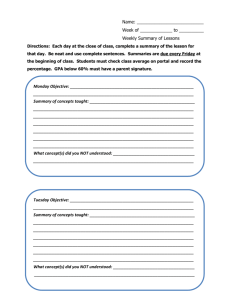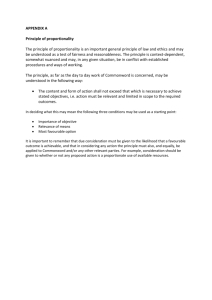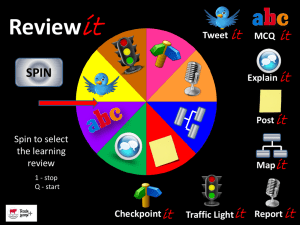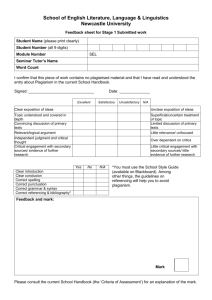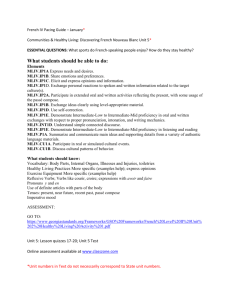TEXT TYPE Quantity of Language Produced NOVICE
advertisement
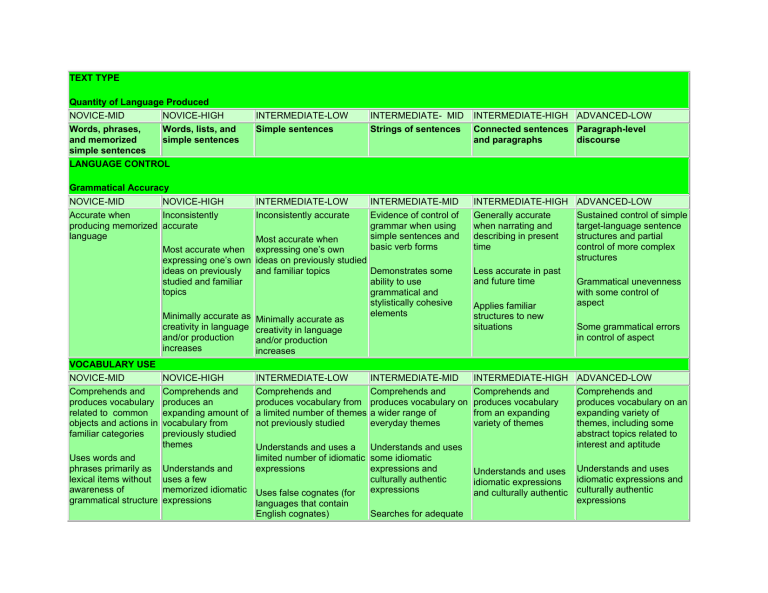
TEXT TYPE Quantity of Language Produced NOVICE-MID NOVICE-HIGH Words, phrases, Words, lists, and and memorized simple sentences simple sentences LANGUAGE CONTROL Grammatical Accuracy NOVICE-MID NOVICE-HIGH Accurate when Inconsistently producing memorized accurate language Most accurate when expressing one’s own ideas on previously studied and familiar topics INTERMEDIATE-LOW Simple sentences INTERMEDIATE- MID Strings of sentences INTERMEDIATE-HIGH ADVANCED-LOW Connected sentences Paragraph-level and paragraphs discourse INTERMEDIATE-LOW Inconsistently accurate INTERMEDIATE-MID Evidence of control of grammar when using simple sentences and basic verb forms INTERMEDIATE-HIGH Generally accurate when narrating and describing in present time Most accurate when expressing one’s own ideas on previously studied and familiar topics Demonstrates some ability to use grammatical and stylistically cohesive elements Minimally accurate as Minimally accurate as creativity in language creativity in language and/or production and/or production increases increases VOCABULARY USE NOVICE-MID Comprehends and produces vocabulary related to common objects and actions in familiar categories Uses words and phrases primarily as lexical items without awareness of grammatical structure NOVICE-HIGH Comprehends and produces an expanding amount of vocabulary from previously studied themes INTERMEDIATE-LOW Comprehends and produces vocabulary from a limited number of themes not previously studied INTERMEDIATE-MID Comprehends and produces vocabulary on a wider range of everyday themes Understands and uses a Understands and uses limited number of idiomatic some idiomatic Understands and expressions expressions and uses a few culturally authentic expressions memorized idiomatic Uses false cognates (for expressions languages that contain English cognates) Searches for adequate Less accurate in past and future time Applies familiar structures to new situations INTERMEDIATE-HIGH Comprehends and produces vocabulary from an expanding variety of themes ADVANCED-LOW Sustained control of simple target-language sentence structures and partial control of more complex structures Grammatical unevenness with some control of aspect Some grammatical errors in control of aspect ADVANCED-LOW Comprehends and produces vocabulary on an expanding variety of themes, including some abstract topics related to interest and aptitude Understands and uses Understands and uses idiomatic expressions and idiomatic expressions and culturally authentic culturally authentic expressions Uses false cognates (for languages that contain English cognates) vocabulary expressions Uses specialized and precise vocabulary for a wider range of topics Uses specialized and precise vocabulary for a limited number of topics Employs generic vocabulary COMMUNICATION STRATEGIES Techniques to understand and to be understood As students progress through proficiency levels, they gain stronger control of the strategies acquired at previous levels while beginning to use new strategies characteristic of the targeted proficiency level. INTERPRETIVE NOVICE-MID NOVICE-HIGH INTERMEDIATE-LOW INTERMEDIATE-MID INTERMEDIATE-HIGH ADVANCED-LOW Identifies a limited Identifies some Identifies a wide range of Uses knowledge of own Identifies the organizing Handles linguistic number of cognates cognates, loanwords, cognates, loanwords, word culture and target principle(s) of oral or challenges with a and loanwords to aid word families, roots, families, roots, prefixes, culture to deduce written text complication or handles an comprehension prefixes, and suffixes and suffixes to aid meaning unexpected turn of events to aid comprehension comprehension Infers and interprets the within familiar contexts and routine situations Uses visual cues to Derives meaning by intent of the author aid comprehension Skims and scans Infers meaning of examining familiar and unfamiliar structures unfamiliar words to aid comprehension Uses background Infers meaning of experience to some unfamiliar Effectively uses enhance words to aid resources, such as comprehension comprehension target language dictionaries and online Uses contextual clues resources, to aid Predicts comprehension Occasionally uses some resources such as target language dictionaries and online resources to aid comprehension Rereads May paraphrase when reading or listening; asks questions of self about text Identifies type of text (narrative, expository, persuasive) Synthesizes Summarizes Evaluates Skips over unfamiliar words (in order to be successful, reader/listener must already have a wide range of known vocabulary to use this strategy) INTERPERSONAL NOVICE-MID NOVICE-HIGH Uses gestures and Generally, but not sometimes resorts to always: English Asks for clarification Repeats Uses limited circumlocution Is understood by sympathetic speakers used to dealing with Self-corrects when language learners not understood INTERMEDIATE-LOW Minimally: INTERMEDIATE-MID Consistently: INTERMEDIATE-HIGH ADVANCED-LOW Uses cohesive devices Rephrases Asks for clarification Asks for clarification Uses some cohesive devices Uses some cohesive devices Uses limited circumlocution Uses circumlocution Probes for details in Conveys message without order to clarify meaning misrepresentation or confusion Uses circumlocution Is understood by native Self-corrects even when speakers unaccustomed to dealing with non-natives not needed for comprehension Self-corrects when Repeats and asks for not understood repetition Repeats and asks for Paraphrases repetition Imitates modeled Occasionally selfcorrects when not needed for comprehension Is understood by sympathetic native speakers accustomed to dealing with non-natives Is generally understood by native speakers of the target language unaccustomed to dealing with non-natives words Paraphrases States lack of understanding Imitates modeled words States lack of understanding Is understood by sympathetic speakers used to dealing with Is generally understood by non-natives sympathetic speakers, particularly by those accustomed to dealing with non-natives PRESENTATIONAL NOVICE-MID NOVICE-HIGH Uses gestures and Generally, but not sometimes resorts to always: English Uses limited Repeats circumlocution Repeats Is understood by sympathetic speakers used to dealing with Paraphrases language learners. Self-corrects when not understood INTERMEDIATE-LOW Minimally: INTERMEDIATE-MID Consistently: INTERMEDIATE-HIGH ADVANCED-LOW Uses circumlocution Rephrases Uses limited circumlocution Uses circumlocution Uses cohesive devices Conveys message without to organize presentation misrepresentation or confusion Self-corrects even when not needed for Is understood by native comprehension speakers unaccustomed to dealing with non-natives Is generally understood by native speakers of the target language unaccustomed to dealing with non-natives Uses some cohesive devices Uses some cohesive devices Repeats Paraphrases Occasionally selfcorrects when not needed for comprehension Self-corrects when not understood Is understood by sympathetic speakers Is understood by used to dealing with Is generally understood by sympathetic native non-natives speakers accustomed to sympathetic speakers, dealing with non-natives particularly by those accustomed to dealing with non-natives * The ACTFL Performance Guidelines for K-12 Learners (ACTFL, 1998), ACTFL Proficiency Guidelines - Speaking (ACTFL, 1999), and ACTFL Proficiency Guidelines - Writing (ACTFL, 2001) were used to inform the development World Languages Performance Level Descriptors table.
